Stockpiling food is a key part of being prepared. Even if you have the skills and space to grow your own, you can’t be sure that a disaster will leave your crops intact and edible. Sure, you can recover from that, but it’s always best to have enough to keep you going while you plant and tend the next crop.
A lot of attention goes to storing bulk carbohydrates like rice, grains and pasta, or home preservation methods like canning or dehydration. Don’t overlook good old shop-bought canned goods though. These can have an impressive shelf life, they’re cheap and a well-chosen stock of them can add variety and nutrients to your diet in the months or even years after the SHTF.
Everyone has different tastes, of course, and what canned goods you decide to buy will be influenced by that.
Here’s our Top Ten canned delicacies:
 #1. Hormel Spam.
#1. Hormel Spam.
Yes, really. Spam is reasonably priced and actually made from good quality meat.
Unlike a lotof processed meat products it isn’t mechanically recovered scrap; it’s chopped pork shoulder and ham. Spam is surprisingly nutritious if you’re in a survival situation; it’s full of the things you need that wellness gurus hate, but your body craves when it’s working hard – fat, sodium and protein.
Spam is also incredibly versatile. It can be eaten straight out the tin, or sliced and used as a sandwich filling. Alternatively you can fry or grill it, add chunks to a stew, make Spam kebabs or chop it up and add some spammy goodness to a pasta sauce or chili.
 #2. Great Value Chunk Chicken Breast.
#2. Great Value Chunk Chicken Breast.
WalMart sell this in 12.5 oz cans, and often have a special offer on a two-pack. What you get is a can of diced chicken breast with rib meat, fully cooked and packed in water. It’s ready to eat, so you can use it to improve a salad.
Alternatively, add it to soups, stews, stir fry or curries. The water from the tin picks up enough chicken flavor to make a pretty good broth, too.
This is a great source of protein.
 #3. Great Value Beef Stew.
#3. Great Value Beef Stew.
Another WalMart staple; this is a 20 oz can of meat, potatoes and carrots and it costs less than two bucks. It’s fully cooked, so you can eat it cold if you have to, and it’s easily heated.
It isn’t the most exciting stew in the world but makes a great base. Add seasonings, or mix in foraged greens; this makes the greens a lot tastier and adds nutrients to the stew.
That’s not to say it isn’t plenty nutritious already; it has loads of fat, protein and energy. Yes, if you’re physically active these are nutrients.
 #4. Kirkland Roast Beef in Beef Broth.
#4. Kirkland Roast Beef in Beef Broth.
Two dozen 12 oz cans of this costs around $90 at CostCo. It’s more expensive than the Great Value stew, but what you get is just chunks of cooked premium beef.
It can be eaten cold, but where it really comes in useful is as an ingredient in stews and other dishes.
It’s very lean, with just enough fat to add flavor.
#5. Hormel Chili with Beans.
Hormel Chili with Beans.
This comes in 15 oz or 38 oz cans, and either way it costs about a dime an ounce.
It’s also tasty and can be eaten right from the can if necessary.
Otherwise it’s a great way to add flavor to rice, beans or even pasta – a 15 oz can and four cups of rice will feed a family.
The chili itself also has a decent amount of fiber, as well as protein and energy.
 #6. Canned Tuna in oil.
#6. Canned Tuna in oil.
Tuna tastes great and has dozens of uses, from tuna salad to pasta sauces and soups. It’s a very good source of protein and essential fatty acids, too.Buy tuna in oil – olive oil if you like it, vegetable otherwise – because it lasts longer and preserves the fish’s nutrients.
Starkist is a good value brand you can find most places, but any tuna will do. It’s best to go for plain old fish instead of a fancy seasoned or roasted variety; you’ll save money, and you can add the finishing touches yourself.
Why pay an extra $1 for a 5 oz can just because there’s a nickel’s worth of garlic in it?
 #7. Baked Beans.
#7. Baked Beans.
These are a great side for breakfast or a whole range of meals. They can also be added to soups, chili, stew and even soups.
They have loads of protein and fiber, they’re tasty and they can be perked up with your favorite seasonings.
Most grocery stores have an economy brand that sells for not very much, so there’s no reason not to have a few cases of these in your store.
 #8. Green Beans.
#8. Green Beans.
Greens can be hard to find in winter, and unless you’ve managed to get a crop in and can some you can find yourself craving them through the cold weather.
Green beans are a simple solution. They’re cheap and can be used in a whole load of different ways. Steam them as a side, drain and mix with dressing or Miracle Whip to make a salad, or add them to soups and stews.
WalMart will sell you a 14.5 oz can of whole green beans for 68 cents.
 #9. Corn.
#9. Corn.
Growing and canning corn is a lot of work; four 15 oz cans of it will cost less than $3.
Like green beans this is a really versatile vegetable that can go in everything from salads to chili.
 #10. Diced tomatoes.
#10. Diced tomatoes.
Get diced tomatoes instead of canned tomato sauce; you can turn them into sauce easily enough with a blender or by forcing them through a sieve, but you can’t turn sauce into tomato chunks if that’s what you’re looking for.
Tomatoes need faster rotation than the other goods we’ve looked at because they’re acidic, but they’re so versatile that shouldn’t be a problem. Soups, stews, pasta sauce… you can add them to practically anything.
They’re not massively nutritious, but they make your cooking taste a whole lot better.
Canned goods have a long life, but to extend that as far as possible it’s vital to store them correctly. Incorrect storage can shorten the life of your food, and even risk dangerous food poisoning.
Check all cans before storage. If there’s any sign of damage, don’t risk it; throw the can away or, if you know it got dented when you dropped it taking it out the car, use it immediately. Dents and dings create weak spots that rust can attack.
Like most other foods cans do best in a cool, dark place that doesn’t suffer from major temperature changes. Freezing temperatures might not obviously split the can, but they could open up tiny gaps that let air and microbes in.
How long you should store canned goods for
- Meat, fish and low acid foods (soup, vegetables) – 3 years
- High-acid foods (tomatoes, pickles, fruit) – 2 years
- Fruit juice – 1 year
Rotate your store periodically; add a few cans to your weekly shop, put them at the back of the shelf and use the cans from the front. That way you’ll keep your stockpile as fresh as possible, so its shelf life is at a maximum when you really need it.

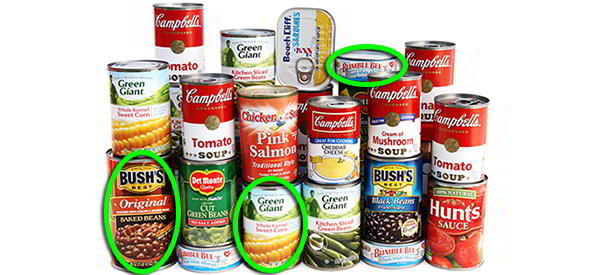
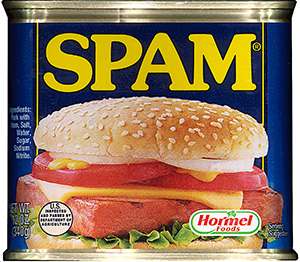 #1. Hormel Spam.
#1. Hormel Spam. 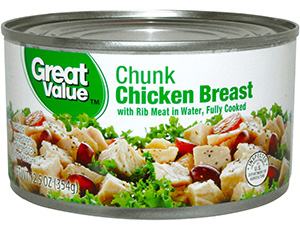 #2. Great Value Chunk Chicken Breast.
#2. Great Value Chunk Chicken Breast.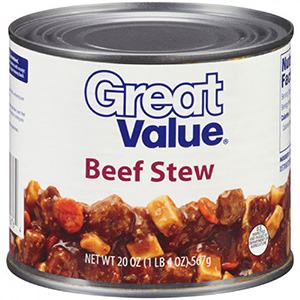 #3. Great Value Beef Stew.
#3. Great Value Beef Stew.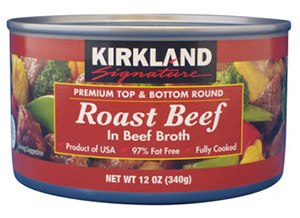 #4. Kirkland Roast Beef in Beef Broth.
#4. Kirkland Roast Beef in Beef Broth.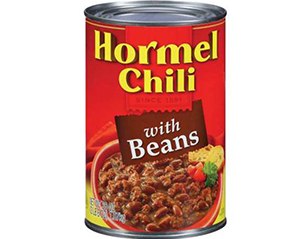 Hormel Chili with Beans.
Hormel Chili with Beans.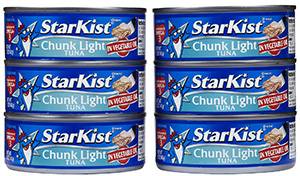 #6. Canned Tuna in oil.
#6. Canned Tuna in oil.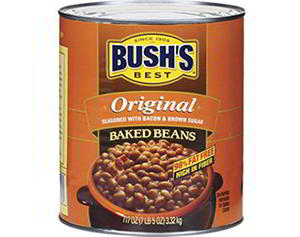 #7. Baked Beans.
#7. Baked Beans. #8. Green Beans.
#8. Green Beans.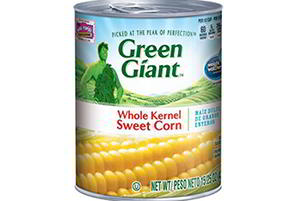 #9. Corn.
#9. Corn.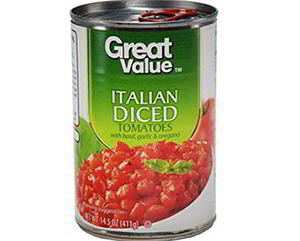 #10. Diced tomatoes.
#10. Diced tomatoes.








